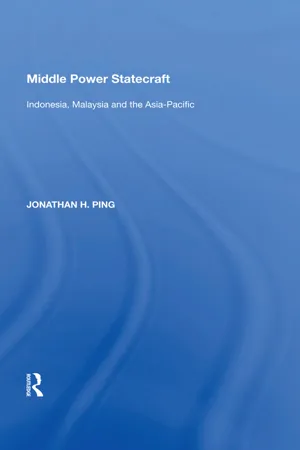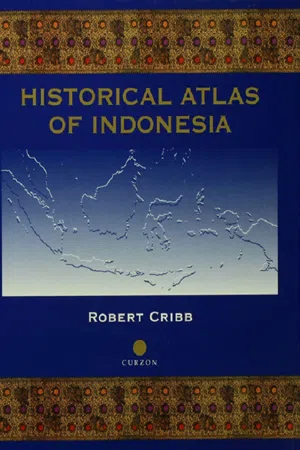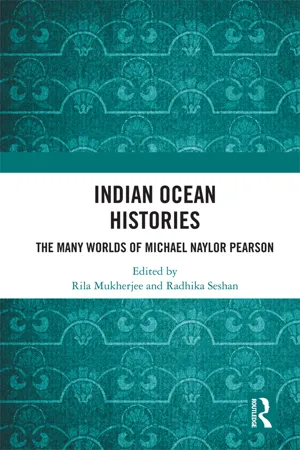History
Majapahit Empire
The Majapahit Empire was a powerful thalassocracy in Southeast Asia, existing from the late 13th to early 16th centuries. It was based on the island of Java and exerted influence over a vast maritime territory, including present-day Indonesia, Malaysia, and the Philippines. Known for its maritime prowess, trade networks, and cultural achievements, the empire left a lasting impact on the region.
Written by Perlego with AI-assistance
Related key terms
Related key terms
1 of 4
Related key terms
1 of 3
4 Key excerpts on "Majapahit Empire"
- eBook - ePub
Middle Power Statecraft
Indonesia, Malaysia and the Asia-Pacific
- Jonathan H. Ping(Author)
- 2017(Publication Date)
- Routledge(Publisher)
The Republic of Indonesia remembers most fondly the second Hindu-Buddhist Indonesian empire of Majapahit. It is often taken as a precedent for the political and geographic boundaries of the contemporary Republic. Starting on Java, the Majapahit Empire expanded from a wet rice economy base and developed naval power, which together established it as the dominant state of the archipelago from the late thirteenth century until the late fifteenth century. Majapahit’s naval power enabled it to attack the Srivijayan capital Palembang in 1377 and to hold authority over vassal states in Sumatra, the Malay Peninsula, Kalimantan and eastern Indonesia. As a trading state it developed diplomatic relations with Champa, Cambodia, Siam, Burma, Vietnam and China (Ricklefs 1993). Majapahit can be recognised as the first state controlling the archipelago, which successfully hybridised Hindu-Buddhist statecraft and PP to sustain a wet rice and trading economy.Knowledge of Majapahit comes from two Javanese inscriptions, Nagarakertagama and Pararaton , both of which have come to us from derived sources. The inscriptions list eight kings and two queens as rulers of the empire from 1294 to 1478. They discuss a civil war and disputed successions, as well as the general procedures and structure of the empire. Chinese records also supplement these. As with Srivijaya, there are sceptics who doubt the existence of Majapahit and its claims. In particular, Professor C. C. Berg argues that supporting documents should be understood as supernatural religious and political myth, which when written, were intended to establish future events. The inscriptions, however, are taken by the majority of scholars as legitimate sources of information about Majapahit (Ricklefs 1993).Hindu-Buddhist influences on the statecraft and PP of contemporary Indonesia and Malaysia should not be over-stated because those of Islam subsumed these more than four hundred years ago (just as Hindu-Buddhist influences did to Animism). However, to overlook such strong and enduring hybridised influences undermines any analysis of Indonesian and Malaysian statecraft and PP. Country-based scholars, particularly ‘Indonesianists’ like Kingsbury (1998), Lowry (1996), Geertz (1993), Moertono (1963) and Anderson (1972), often employ hybridised PP norms from the Hindu-Buddhist period to either interpret statements by government officials or to explain behaviour patterns within foreign and domestic policy. Similar scholarship can be followed to develop the MP concept. - eBook - ePub
Southeast Asia
Past and Present
- D R SarDesai(Author)
- 2018(Publication Date)
- Routledge(Publisher)
The Nagarkertagama perhaps gives him more credit than was due as an empire builder. Thus, it speaks of the Majapahit hegemony extending not only over the entire archipelago (except western Sunda) but also over Champa, Thailand, and Cambodia, comparing its domain with China’s. Most modern historians discount the premise that an extended Majapahit Empire could include territories on mainland Southeast Asia. In their view, the Majapahit Empire was limited to the Indonesian archipelago except western Sunda, which retained its independence until early in the sixteenth century. During the nationalist movement in the twentieth century, some of the Indonesian leaders, including Sukarno, argued that Indonesia had historically been a united state under Gajah Mada, thus refuting Dutch claims that Western colonial rule had brought the people of the archipelago together for the first time. Independent Indonesia has honored Gajah Mada’s memory by naming the main street of Djakarta and the university at Jogjakarta after this much-admired administrator of the fourteenth century.The period politically dominated by Gajah Mada and King Rajasanagara marked the golden age of Javanese history, known for literary and cultural efflorescence. Most notable of the literary works produced under extensive royal patronage were The Nagarkertagama, by the poet Prapanca, and Arjunavivaha and Purushadasanta (or Sutasoma ), by the poet Tantular. The fourteenth century also brought major construction, including that of many religious edifices dedicated to the syncretic cult of Shiva-Buddhism, noted for their bas-reliefs depicting scenes from The Ramayana and The Krishnayana. These monuments represent an advanced stage in the evolution of Indo-Javanese art, in which the Indian forms became more completely assimilated and the Indonesian elements and attitudes asserted themselves most clearly.The Majapahit glory lasted only about seventy-five years, although the state lingered on until it was slowly liquidated by the advance of Islam in the first quarter of the sixteenth century. The Majapahit was the last great Hindu kingdom of Southeast Asia. A war of succession between 1401 and 1406 weakened it at a time when a new state, Malacca, which would eventually be the most responsible for its decline, emerged. After the establishment of Malacca in 1402, the trader-rulers of many small states converted to Islam in the hope of better promoting their trade prospects, thereby severing their ties with Hindu Majapahit. Majapahit’s central position in international commerce then passed increasingly to Malacca. The Thais also showed an urge to expand in the Malay Peninsula and to secure for themselves a more important commercial role, thereby making the contest for supremacy triangular. By the early sixteenth century, Majapahit had sunk to being just one of a number of small Javanese states whose glory had become only a distant memory. - eBook - ePub
- Robert Cribb(Author)
- 2000(Publication Date)
- Routledge(Publisher)
claimed for Majapahit an empire of 98 tributaries, stretching from Sumatra to New Guinea, but some scholars have seen this claim as representing only a sphere of limited influence or even as being no more than a statement of geographical knowledge. There is no doubt, however, that Majapahit fleets periodically visited many parts of the archipelago to obtain formal submission, or that the splendour of the Majapahit court led many regional rulers to send it tribute, in much the same way as they sent tribute to China, without any intention of submitting to orders from eastern Java. The trading power of Majapahit gave it a powerful sanction against defiant rulers. The eastern Java kingdom established especially close trading links with pepper suppliers in Sumatra and with other spice-producing regions in eastern Indonesia. It is probably best, therefore, to see Majapahit’s claims of empire as representing real authority, with the proviso that such authority never gave Majapahit significant administrative power outside Java, Bali and Madura.Majapahit reached the pinnacle of its power under the rule of Rajasanagara (r. 1350–89), better known as Hayam Wuruk, and his prime minister, Gajah Mada, who held office from about 1331 until his death in 1364. Under their joint rule, Majapahit seems to have been particularly successful in establishing closer royal rule in the Brantas valley, by means of royal charters on land and other productive resources such as ferries. These charters diverted taxation income from local elites to the royal treasury and enabled the king to pay for a network of roads which made communication within the region easier. The capital city itself reflected the ruler’s wealth, with high, thick walls of brick, spacious pavilions and abundant flowers.After the death of Hayam Wuruk in 1389, Majapahit went into decline. Its influence abroad contracted and it was wracked by civil war and succession disputes at home. Little is known of Javanese history in the 15th century. Majapahit is traditionally said to have fallen in 1478, but the state seems to have survived in attenuated form until about the 1530s. Hindu–Buddhist states such as Pengging, Kediri and Balambangan emerged within the former territory of Majapahit, but none was able to recreate its dominion, even in eastern Java.Instead power shifted to trading city-states of the north coast, notably Demak, which had converted to Islam in the late 15th century. The struggle of Muslim Demak and its coastal allies with the Hindu-Buddhist states of the interior possibly had some elements of religious war, but at stake was also the question of whether Java’s growing role in international trade could pull the centre of Javanese power away from the interior and to the coast. - eBook - ePub
Indian Ocean Histories
The Many Worlds of Michael Naylor Pearson
- Rila Mukherjee, Radhika Seshan, Rila Mukherjee, Radhika Seshan(Authors)
- 2019(Publication Date)
- Routledge India(Publisher)
Others assert that this self-proclamation was no more than a statement of contemporary geographical knowledge rather than a documentation of Java’s regional sovereignty. There is no doubt, however, that Majapahit Java-based fleets periodically visited many parts of the archipelago on Majapahit diplomatic and commercial missions. In the Negarakertagama, ‘ambassadors’ were said to have obtained formal regional submissions to Majapahit, and in return, Majapahit ships maintained the stability of a largely open regional trading system. The splendour, regional presence and overall authority of the Majapahit court led many regional rulers to send it tribute in much the same way as they periodically dispatched tribute to contemporary Ming China’s court. 2 Majapahit’s trading prominence paired with its role as a regional cultural centre to provide Majapahit with a powerful sanctioned base to stand against defiant regional rulers. The east Java-based mixed maritime and agricultural kingdom, in contrast to the prior upstream central Java polities, did in fact establish especially close trading and cultural links with pepper suppliers in Sumatra and the spice-producing regions in Indonesia’s eastern archipelago. Thus Majapahit’s contemporary textual assertions that it was a regional ‘empire’ grounded in arbitrary regional inclusion rather than institutionalised centrality was truthful, as regional literature acknowledges local emulation of Majapahit’s cultural achievements and wider marketplace connections rather than acknowledging submission to its political authority, as in reality Majapahit never had affective administrative power outside its Java, Bali and Madura core. 3 Majapahit, Straits of Melaka and Java Sea regional identities c
Index pages curate the most relevant extracts from our library of academic textbooks. They’ve been created using an in-house natural language model (NLM), each adding context and meaning to key research topics.
Explore more topic indexes
Explore more topic indexes
1 of 6
Explore more topic indexes
1 of 4



